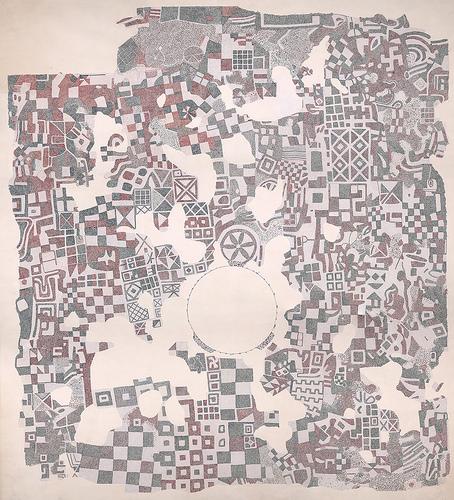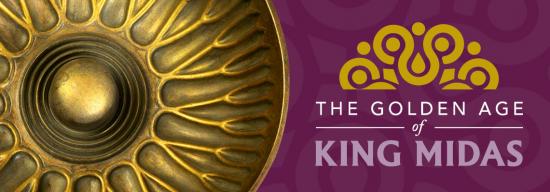PART.2
Midas on the World Stage
Gordion is immense, about 2.5 miles wide. Penn Museum continues excavations and conservation projects on and around the citadel, a high fortress at the heart of Phrygia’s capital city, where hundreds of people lived and worked. A 3-D model of the citadel, enlivened by light and sound projections, offers guests a bird’s eye view. In the 1950s, archaeologists uncovered the oldest colored pebble mosaic floor known in the world in a large citadel building. Dated to the late 9th century BCE, it measures 35 by 31 feet; a recently conserved section of that floor, roughly five feet long, will be on display in the exhibition.
 This watercolor is of a colored pebble mosaic floor in a large building—the earliest known pebble mosaic floor in the world—excavated inside the citadel at Gordion in central Turkey in 1956. The mosaic, which measures 35 x 31 feet, is dated to the late 9th century BCE. Photo of watercolor by Joseph Last, 1956, Penn Museum Gordion Archive, 400833, Plan1956-17.
This watercolor is of a colored pebble mosaic floor in a large building—the earliest known pebble mosaic floor in the world—excavated inside the citadel at Gordion in central Turkey in 1956. The mosaic, which measures 35 x 31 feet, is dated to the late 9th century BCE. Photo of watercolor by Joseph Last, 1956, Penn Museum Gordion Archive, 400833, Plan1956-17.
 Part of the colored pebble mosaic floor, the oldest known in the world, found in a large hall excavated inside the citadel at Gordion in 1956. One of 33 panels removed for conservation and display in 1963, this piece was newly conserved in the summer of 2015 by the team at Gordion. It dates to the late 9th century BCE. Photo: Penn Museum Gordion Archive, 2015_04663.
Part of the colored pebble mosaic floor, the oldest known in the world, found in a large hall excavated inside the citadel at Gordion in 1956. One of 33 panels removed for conservation and display in 1963, this piece was newly conserved in the summer of 2015 by the team at Gordion. It dates to the late 9th century BCE. Photo: Penn Museum Gordion Archive, 2015_04663.
The story of King Midas is the story of influence and power on an international stage with neighboring kingdoms on all sides. Here, the Penn Museum’s own collections shine: visitors are introduced to the spectacular gold work of the nomadic Scythians and the Lydians; distinctive metalwork of the Urartian Empire; monumental stone and ivory reliefs of the Assyrians; and stone sculpture of powerful Persia, which conquered Gordion in the 6th century BCE. An animated map provides a flyover of the region during and just after Midas’ time.
Gordion After Midas
While the Phrygian period at Gordion is the most renowned, this strategically situated site contains thousands of years of history, and the exhibition sheds light on what happened in Gordion in the centuries after King Midas ruled.
Guests will see fragments—and remarkable watercolor recreations by renowned archaeological illustrator Piet De Jong—of the famous “Painted House” built about 500 BCE, and excavated in Gordion’s citadel during the 1950s. The Painted House murals provide a rare glimpse into the religious rituals of the citadel’s residents, and the lives of its women, 200 years after the death of King Midas.
One of the most important historical accounts involves Alexander the Great’s 333 BCE visit to Gordion, where he purportedly cut the “Gordian Knot.”
The Exhibition Team
Dr. C. Brian Rose, Penn Museum’s Gordion Archaeological Project Director, is the exhibition curator, and worked with Turkish colleagues to select the loaned artifacts. Kate Quinn, Exhibition and Public Programs Director, led the exhibition team that included in-house interpretive planner Jessica Bicknell, and a team of in-house designers, as well as outside collaborators including Night Kitchen Interactive and Wish Design, Painting and Sculpture.
The Golden Age of King Midas is made possible with support from the 1984 Foundation; the Selz Foundation; Frederick J. Manning, W69, and the Manning Family; the Susan Drossman Sokoloff and Adam D. Sokoloff Exhibitions Fund; the Turkish Cultural Foundation, and Joan Bachman in honor of Mary Bert Gutman.
Source: Penn Museum press release.
 Exclusive World Premiere Exhibition | February 13 through November 27, 2016
Exclusive World Premiere Exhibition | February 13 through November 27, 2016